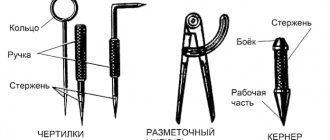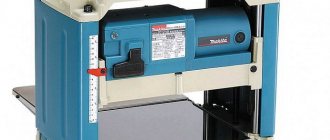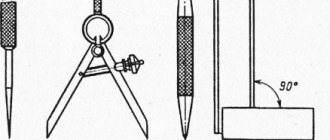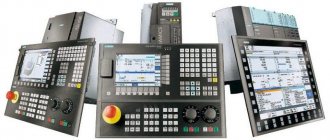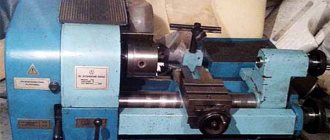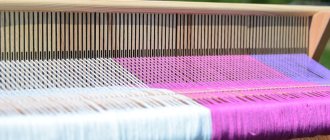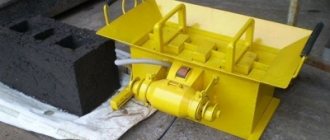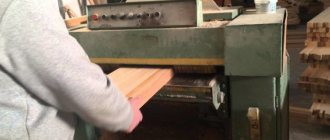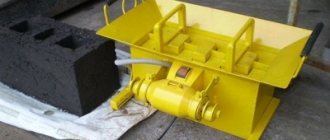Thicknesser machines are often used in the construction industry for processing parts made from different types of wood. The machines are designed to give workpieces the desired size and shape. With their help, boards or timber of a certain thickness and width are obtained.
The design features of the machine make it possible to process parts or obtain finished products with the required parameters with millimeter precision. Using a thicknesser, you can plan workpieces in one plane, adjusting the thickness of the board. The workpiece being processed is guided through a special mechanism that simplifies the operation of the machine.
Description
Quite often, novice craftsmen do not know what a surface planer is. If you, too, are among them, then you must understand: the device described is equipment with a cutting tool in the form of a knife shaft. The workpiece is fed along a horizontal table, which is the working table in the machine.
Today, single-sided and double-sided machines are known. The former have one knife shaft, which is designed to remove material from the upper part. Double-sided devices have an additional blade shaft located on the work table. The element is based on the surface, and if fixation is necessary, it is carried out by a bar and side rollers. Retention is provided by rollers that facilitate feeding. The latter can also be manual. A double-sided thicknesser machine is similar in design features to jointing equipment, so such units are often combined, which makes it possible to obtain jointer-thicknesser devices.
Safety precautions
Before work you should:
- tuck in clothes, button up sleeves, make sure that the edges of clothes do not hang down;
- inspect the work area, remove all unnecessary objects that may get in the way;
- take care of high-quality lighting of the working area.
Preparation of devices
At this stage, you need to make sure that auxiliary equipment is available and working correctly to prevent the workpieces from being thrown back.
If long workpieces are to be processed, the output part of the work table should be extended, and a stand on rollers can be installed in front of the machine.
Checking the serviceability of the surface planer
- the machine plate must have a smooth surface, without depressions or other defects;
- The blade shaft must be well balanced. You can check this parameter by rotating the shaft, after first removing the drive belt from it. If the shaft remains in a stationary position when stopping, then everything is in order;
- the front table should rise and fall well;
- the surface of the grooved rollers should not be worn out or cracked;
- The upper feed rollers must be closed from the workplace.
During work
- You can only process workpieces whose length is not less than the distance from the front to rear feed rollers + 5 cm;
- a workpiece whose thickness is less than 0.5-1 cm must be processed with a wooden backing;
- before work, each workpiece must be inspected for flaws, if detected, the part should be set aside for additional cutting;
- It is necessary to plan according to the structure of the fibers. This will provide better processing;
- When planing pine wood, the surface of the table should be wiped with a rag moistened with kerosene or diesel fuel. In this way, the resin is removed, which impedes the progress of the workpiece;
- the protective devices should not be removed;
- you cannot clean the workplace, as well as lubricate, adjust and repair the machine while it is moving;
- Do not store parts, processed products, tools, rags, etc. on the surface planer table;
- In the event of a sudden power outage, or when you are away, you must turn off the machine.
Upon completion of work
Turn off the machine. You can start cleaning only after the blade shaft stops rotating. Use brushes or brushes to remove shavings and sawdust.
Purpose
If you are also interested in what a thickness planer is, we will remind you that it is a massive or portable device that provides thickness calibration of workpieces. The unit is designed for finishing planing to a certain thickness. The boards are passed through a surface planer, while the top layer of the tree is planed using a wide shaft with blades.
Thicknessers are in demand in carpentry because they can be used to calibrate products for flush joints. A smooth surface is obtained by connecting parts of the same thickness. Quite often, consumers who understand what a thickness planer is have an erroneous opinion about this device, which is expressed in the fact that the unit makes straight ones from curved workpieces. The main purpose of the machine is to provide the required size. Therefore, the part must initially have at least one of its sides flat.
Manual carpentry thicknesser
The simplest marking thicknesser is a board with a ledge (bracket) into which a scriber is inserted. A scriber can be, for example, a nail driven in so that its sharp end sticks out and allows you to draw a line.
The thicknesser works very simply: the carpenter guides the bracket along a flat surface with the ledge, and draws a marking line with the sharp end. Naturally, with such a tool it is possible to apply markings only at one, unchangeable distance from the ledge. In order to be able to draw a line at different distances from the ledge, the surface planer is made up of two parts; marking strip and base, which can move relative to each other. Also, such a tool requires a mechanism for fixing its parts after setting the required distance. This mechanism can be a hardwood wedge or a screw. To make it easier to mark the markings, you can stick a ruler with divisions on the staff.
There are many varieties of marking strips, differing both in the material for which they are intended and in the ability to apply more complex markings than one straight line. For example, tenon and groove marking gauges allow you to quickly and accurately mark joinery joints on multiple parts.
Design features
Thicknessers are based on a powerful motor. He is responsible for rotating the shaft with knives using a belt drive. The upper part of the device is movable; it runs along vertical guides. An adjustment mechanism with inch and millimeter scales is used to set a specific thickness.
Typically, thicknessers for wood have automatic product feeding. The rollers move the workpiece at a certain speed in front of and behind the knife shaft. About 8 m of material can be processed in one minute. The user only needs to place the workpiece on the work surface and feed it inside, and then accept it from the back side. This function is useful because it saves energy.
Some household thicknessers have two automatic feed speeds - high and low. The first ensures quick completion of work, while the second allows you to achieve maximum surface quality.
Specifications
The main characteristics of surface planers are:
- weight;
- workpiece size;
- power.
The latter usually reaches 1800 W. The maximum thickness and planing width is the caliber of the thicknesser. These characteristics describe the permissible dimensions of the workpiece. The maximum planing width usually reaches 330 mm, while the thickness is 152 mm. The first parameter shows how wide a board you can process if you install it on an edge. These numbers do not mean that the surface planer is intended for planing massive and long boards. Their device simply won’t be able to get through. The optimal caliber is relatively small workpieces.
Thicknesser is a machine that is characterized by a certain planing depth. This feature shows how much wood can be removed at one time. The described equipment has a maximum depth of 3.2 mm. Wide boards should not be planed to extreme depth. As product sizes increase, the planing depth per pass decreases. The rotational speed of the knife shaft in surface planers reaches 10,000 rpm. The higher the speed, the better the quality of the planed surface.
Types and methods of troubleshooting possible problems
| Problem | Cause | Elimination |
| The knife shaft does not rotate when starting the machine | 1.No power supply. 2.Automatic shutdown of thermal relay. 3.The guard is not secured to the knife shaft | 1.Check the electricity supply. 2. Turn on the thermal relay. 3.Install and fix the device, check and adjust the operation of the switch that blocks the safety fence |
| It is not possible to drive the workpiece into the machine (the part is slipping) | 1. The feed rollers do not apply enough pressure to the part. 2. Insufficient protrusion of the lower rollers | 1.Adjust the pressing force of the feed rollers. 2.Adjust the height of the rollers |
| The size of the processed workpiece does not correspond to the specified parameters | 1.The table is not configured correctly. 2.The table is not fixed. 3. The knives are dull | 1.Adjust the table. 2.Secure the table. 3.Change knives |
| The surfaces of the machined part are not parallel to each other. | 1.Knives are not installed level. 2.The lower rollers are not parallel to the table surface | 1.Adjust the position of the knives. 2. Correctly align the lower rollers |
| Transverse gouges at the ends of the workpieces | 1.The lower bolsters protrude too much above the table. 2.Clamps are not positioned correctly | 1. Set the lower rollers to the correct position. 2. Correctly align the clamps in relation to the pressure shaft |
| Longitudinal grooves on the machined part | Local defects on the cutting blade edge | When planing narrow parts, avoid defects or replace knives |
| The processed part acquires a wavy surface | 1. Knives are not positioned correctly. 2. The knife shaft hits the workpiece | 1.Adjust the position of the knives 2.Balance the knife shaft by selecting the knives by weight, weighing them on balancing scales |
| The grooved shaft leaves marks on the processed workpiece | The front shaft presses the workpiece too hard | Adjust the shaft clamping force |
| During processing, wood fragments are chipped and torn out in places. | 1. The knives protrude too much above the knife shaft housing. 2.Insufficient planing allowance left | 1.Adjust and set the knives in relation to the body by 1-2 mm. 2.Blanks are sorted into scrap |
| When processing, lint rises on the surface of the part | 1. The knives are dull. 2. Replacement inserts worn out to prevent chipping | 1.Change knives. 2.Change earbuds |
As you can see, the productivity and quality of the machine is determined by many different factors that must be taken into account during the work process. If more serious problems occur, please contact qualified personnel.
The need to use a chip extractor
Woodworking thicknessers throw out large volumes of shavings during operation. It is best to remove it using a construction vacuum cleaner. If this is not done, waste will clog in the equipment. They penetrate the moving mechanisms and enter the planing area. All this reduces the quality of processing.
As a result, the master is unable to obtain a smooth surface of the workpiece. In support of the need to use a lumber waste disposal device, cleanliness in the workplace is also important.
Bench thicknesser
In plumbing work, a special type of surface planer is used. A bench planner is a vertical stand on a horizontal platform, to which an inclined scriber is attached. By moving the scriber along the vertical stand and sliding it out or in, you can get any distance from the base side of the platform. The selected position is fixed with screws and the tool traces a template or base plane so that the scribe leaves marks on the workpiece.
Also in plumbing, a height gauge is used, which is an analogue of a caliper with a base scale mounted on a stand. With this tool you can measure heights and draw marks at a given height.
What is a Metabo DH 330 machine?
To fully understand what a surface planer is, you can consider similar equipment using the example of a specific model. Metabo DH 330 costs 37,400 rubles. and is a portable, convenient machine designed for planing bars of a certain height and width. The cast frame ensures reliable installation of the product on the table and high accuracy of operations.
Dangerous parts of the unit are securely hidden in the housing. If you need a thickness planer, you can consider purchasing a woodworking machine from Metabo. Its power consumption reaches 1800 W. The maximum processing width and planing depth are 330 mm and 3 mm respectively. The knives have the following dimensions: 332 x 12 x 1.5 mm. The part in the machine moves at a speed of 7 m per minute.
The equipment uses a belt drive. The model weighs 35 kg. The overall dimensions of the installation are 579 x 857 x 574 mm. You may also be interested in the diameter of the planing shaft, it is 47 mm. Its rotation is carried out at a speed of 9800 revolutions per minute. When choosing a thicknesser, consumers often pay attention to the diameter of the aspiration hole. This parameter is equivalent to 102 mm.
Positive features of the machine
In order to decide which thickness planer model to choose, you should consider its positive features, among others, the Metabo DH 330 should highlight:
- fine adjustment;
- choice of chip thickness;
- Possibility of installation on a table.
As for the possibility of adjustment, it is provided in relation to the thickness of the planing and is carried out by turning the handle. By looking at the scale, you can see the graduation of the required height. The design includes a panel with which you can select the thickness of the chips to be removed, which reaches 3 mm. The machine is also good because it can be installed on a table. This ensures ease of use.
Cost of knives
In addition to the equipment, you may need thicknesser knives. Their price is 4100 rubles. These are double-sided cutting elements for planing processing. Suitable for all types of wood. It is based on a pure-grade hard alloy with a cobalt content of 18%. Consumables can be re-sharpened, which guarantees a long service life. Knives are made from high-speed steel HSS. Their thickness, width and length are 1.5 x 332 x 12 mm, respectively. The package contains two cutting elements.
Power consumption
Basic models have a power consumption of about 1200 watts. This type of machine will be used for planing small pieces of wood and is more suitable for soft wood.
- If you want to use the power of the combination machine, please note the power consumption from 1500W.
- To give you a better idea, semi-pro and professional machines start at 2000 watts.
- Don't forget to check the thicknesser's power supply to see if it can be plugged into a standard 230V outlet.

